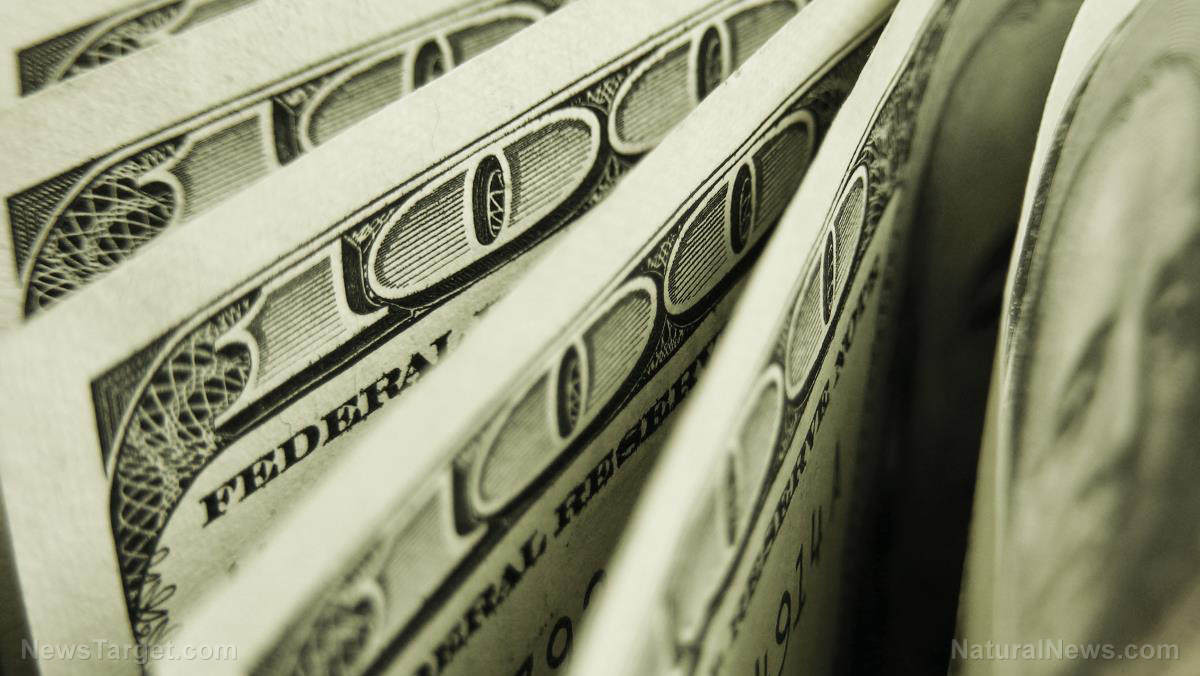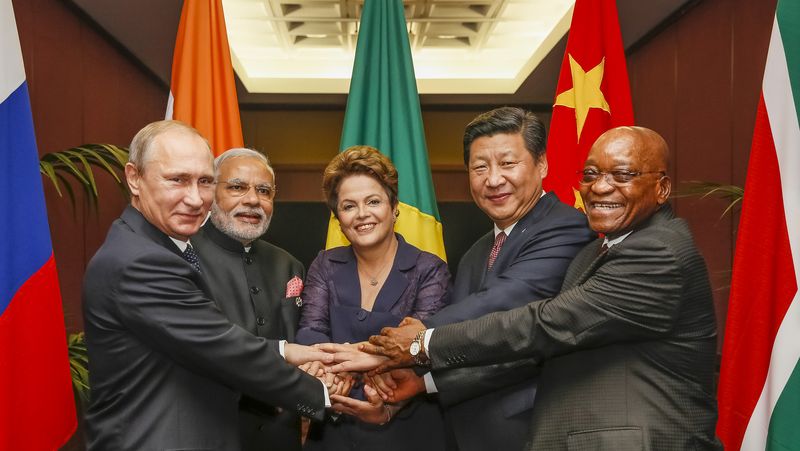The bell tolls for fiat
07/14/2023 / By News Editors

The importance of Russia’s announcement that a new gold-backed trade currency is on the BRICS meeting agenda for August 22—24 in Johannesburg seems to have gone completely over everyone’s heads, with mainstream media not even reporting it.
(Article by Alasdair Macleod republished from GoldMoney.com)
This is a mistake. China and Russia know that if they are to succeed in removing the dollar from their sphere of influence, they have to come up with a better alternative. They also know they have to consolidate their trade partners into a formidable bloc, so plans are afoot to consolidate BRICS, the Shanghai Cooperation Organisation, and the Eurasian Economic Union along with those nations who wish to join in. It will be a super-group embracing most of Asia (including the Middle East), Africa, and Latin America.
The groundwork for the new currency has been laid by Sergei Glazyev and is considerably more advanced than generally realised.
This article explains why Russia and China are now prepared to fully back Glazyev’s expanded project. For Russia, it is also now imperative to destabilise the dollar as a deliberate escalation of the financial war against America and NATO. China’s priority is no longer to protect her export trade, but to ensure that her African and Latin American suppliers are not destabilised by higher dollar interest rates.
Introduction
“The BRICS’s introduction of a gold-backed currency, which is supported by 41 countries with large and influential economies, will weaken the dollar and the euro and will benefit countries such as Iran, while Iranians in possession of gold will experience a wealth increase,” Mousavi added [the head of the South Asia Department at Iran’s Foreign Ministry]. The Russian government confirmed a day earlier that Brazil, Russia, India, China, and South Africa would introduce a new trading currency backed by gold.
The quote above encapsulates why a new gold-backed currency is desired: it will undermine fiat currencies which have been no friends to oil producers and benefit individuals who own gold making it popular on the streets. RT, the Russian government-financed English broadcasting service had confirmed on last Friday the intention to introduce a new gold-backed currency for BRICS members. The announcement was completely missed by mainstream media, partly because RT and other Russian news sources are censored in many countries in Europe including the UK, and any news out of Russia is disbelieved anyway.
Reactions from those who saw it, even among gold bugs, vary from the opinion that neither China nor Russia could make a gold backed currency stick, to it taking years in the planning and implementation so is irrelevant to today’s markets. But there are good reasons to believe that this complacency will turn out to be wrong, and that events are likely to evolve considerably more rapidly than expected.
The problem for capital markets is that they are dominated by Keynesians, automatically programmed to believe gold is bad and fiat is good. As a stockbroker in London, when President Nixon suspended the Bretton Woods Agreement, I recall there was a similar level of confusion over those implications. And now, 52 years after putting the world on a fiat dollar standard, the majority of the world has had enough of dollar hegemony, has found safety in numbers, and is going back onto a gold standard. Like all life, the pure fiat era is ephemeral after all, defined by its birth and death. Macroeconomics will have to be rewritten.
The move away from fiat has been evolving for a considerable time, with de-dollarisation the ultimate objective of the Asian hegemons. Those tracking developments in gold bullion markets in recent decades have noted the drift of bullion from west to east, and the rise in gold mine output in China and more recently in Russia. Central banks, predominantly in Asia, have been accumulating bullion reserves and adding to declared and undeclared state funds in record quantities. Ultimately, this activity can only be to use gold to secure currency values as the dollar dies or is done away with.
A sudden turn of events occurred when the western alliance imposed sanctions against Russia following her attack on Ukraine. They set off a train of actions that has unified Asia and many of its supplier nations into a rebellion against American hegemony, stoked up by Putin and led by Saudi Arabia and the Gulf Cooperation Council. And since the western alliance turned its back on fossil fuels, the low-cost producers throughout Asia have banded together representing nearly half global oil output, and a third of natural gas. As a cartel, OPEC is now just an appendix to the Asian mega-energy producers.
The new cartel is dominated by President Putin, whose degree from Leningrad University was in energy economics and well qualified to be energy ringmaster. Not only has he demonstrated an understanding of the importance of controlling global energy supplies, but he also has a clear understanding of the importance of monetary gold.
Since the western alliance’s sanctions, the signals coming out of Moscow have been clear: Sergei Glazyev, who is Putin’s point-man for macroeconomic policy has been waving the gold flag since then in plain sight. As a board member of the Eurasian Economic Union Commission (EAEU) since 2019, he was tasked bycolla Putin to design a trade settlement currency for the EAEU. The initial statement through a news agency in Bishkek in early March 2022 reported that it was to be based on the currencies of the member states and a basket of undefined commodities. According to Glazyev, his brief was to create a Eurasian monetary and financial system to the exclusion of foreign currencies, particularly the dollar and euro.
The intention was also to remove exchange controls for cross- border settlements within the Eurasian membership, replacing the dollar as the commonly used settlement medium between them. A week later, in an article for Goldmoney[ii] I concluded that as stated the new currency would not work, and the only logical solution was to do away with the currency basket proposal and use gold backing solely to represent commodities. That way, it would be easy for other nations in the Shanghai Cooperation Organisation (SCO) to join in, which was the ultimate objective from the outset.
In July 2022, Glazyev was behind a move to beef up the Moscow gold exchange, the official line being that having been sanctioned from the London market Russian miners needed a more effective local market. But working in conjunction with the Shanghai Gold Exchange this was an important signal about the way Galzyev’s monetary thinking was developing. Confirmation came on 27 December last year, when he wrote an article for Vedomosti, a Moscow business paper, describing why the rouble needed to return to a gold standard. That article was co-written by his deputy on the EAEU committee designing the new trade currency and was a thinly veiled indication of the committee’s view.
Therefore, you did not have to be particularly astute to discern the trail of clues presented to us. We could assume with justification that gold was intended to be the sheet-anchor for this new currency probably from the outset, but some political hoops had to be jumped through to convince the EAEU member states that it was the solution.
The impracticality of basing a new trade currency on anything else other than gold had been established. It now turns out that this project is almost certainly a Trojan horse for something far larger. It was obvious that other members of the Shanghai Cooperation Organisation should be able to join in, and now it turns out that the invitation is being extended to members of the BRICS club as well. But that’s not all. The entire membership of the SCO, its dialog partners, and associate members will be attending the BRICS conference in Johannesburg on 22—24 August. I am assuming that the original list of 36 nations, which according to most recent reports has expanded to 41, includes the members of the EAEU who were not on the original list — at the time of writing this is yet to be confirmed.
That being the case, the BRICS currency project is not a cold start and not something to be planned for a distant future. The groundwork has already been prepared by Glazyev and the structure can be rapidly assembled once the necessary resolution is adopted. It is even possible that the necessary institution(s) exist waiting to be deployed.
It is also beginning to look like there will be another proposal on the Johannesburg agenda, to merge the SCO, the EAEU and BRICS into a supersized trading block. In terms of both combined population and GDP on a purchasing power parity basis, it is already in excess of half the world, dwarfing the western alliance which kowtows to America.
The US Treasury would almost certainly have known about the BRIC proposals when the agenda was first circulated, which probably explains why at short notice Janet Yellen, US Treasury Secretary flew to Beijing. From her department’s point of view, if the new currency proposal was to be adopted its financing of the budget deficit would be adversely affected, not to mention the threat to the dollar’s hegemony. The principal card up her sleeve was to threaten greater sanctions against China’s exports, not just to America, but to her allies as well, but we don’t know if it was actually discussed in these terms.
The Chinese view
For too long and too often China has been threatened over access to markets by the Americans. We can be sure that ahead of the BRICS currency proposal the Chinese have gamed this possible threat being acted upon and come up with their own conclusions about its economic consequences. Russia’s experience, which harmed the sanctioning countries considerably more than the sanctioned, will have been fed into these calculations. One suspects that other than signalling to the Chinese and Russians that there is an increasing level of alarm in Washington, Yellen’s mission will have achieved little. And an important factor for the Chinese attitude is their experience of the US’s attempts to destabilise Hong Kong, which led to it being taken directly under Beijing’s control. It is therefore important to understand China’s analysis of America’s objectives and methods in order to define her own position.
In April 2015, Qiao Liang, the People’s Liberation Army Major-General in charge of intelligence strategy gave a speech at a book study forum of the Chinese Communist Party’s Central Committee.[iii] Qiao commenced by stating the obvious, that the U.S. enforces the dollar as the global currency to preserve its hegemony over the world. And he concluded that the U.S. would try everything, including war, to maintain the dollar’s dominance in global trading. But what he then went on to say is extremely relevant to the current situation. He described US’s actions with respect to foreign national debts.
Qiao made the case that both the Latin American crisis in 1978—1982, and the Asian crisis in 1996—1998 were engineered by America. By reducing dollar interest rates to below their natural level they would weaken the dollar and encourage an investment boom in the targeted jurisdictions, funded by dollar credit. They then increased interest rates and strengthened the dollar to create a financial crisis. These events did, indeed, happen, but perhaps driven by the cycle of bank credit, as much as by foreign policy.
The relevance of Qiao’s analysis is that today, the same conditions appear to be targeted not against China, which does not borrow dollars, but at the dollar indebted nations around the world with which China trades — the BRICS nations. Informed by Qiao’s analysis, it must appear to China that America’s persistent strategy is to continue to raise interest rates even after the inflation dragon is slain, and by bankrupting them the US will attempt to bring the nations seeking to join BRICS back under her control.
That being the case, China will have weighed up the consequences for her export trade against the likely sanctions America and her allies could threaten and decided that the real threat is against the emerging economies in Africa, Latin America, and elsewhere which have received substantial Chinese investment. In financial terms, it is therefore imperative that this threat be addressed in a pre-emptive attack on the dollar, which can only be achieved by exposing the dollar’s weakness as a fiat currency. At least since the Lehman crisis, China and more recently Russia have had the power to do this.
Furthermore, the New Development Bank, which is headquartered in Shanghai, will be able to provide credit either in yuan or the new BRICS currency at lower interest rates to offset the undoubted strains imposed on BRICS members as a result of rising US interest rates. Therefore, China is fully prepared to counter what General Qiao Liang described as the American strategy of “harvesting” assets in foreign countries.
It is important to understand what China believes and motivates her, not whether Qiao is right or wrong. But given that his view is inculcated in the Chinese government, China is ready with Russia to mount an attack on America’s fiat currency by returning to a gold standard for trade, and ultimately for their own currencies.
Read more at: GoldMoney.com
Submit a correction >>
Tagged Under:
big government, BRICS, bubble, chaos, China, collapse, conspiracy, currency crash, currency reset, dedollarization, dollar demise, economic riot, fiat, finance, finance riot, gold, market crash, money supply, risk, Russia, US, White House, World War III
This article may contain statements that reflect the opinion of the author
RECENT NEWS & ARTICLES
COPYRIGHT © 2023 DeDollarization.news
All content posted on this site is protected under Free Speech. DeDollarization.news is not responsible for content written by contributing authors. The information on this site is provided for educational and entertainment purposes only. It is not intended as a substitute for professional advice of any kind. DeDollarization.news assumes no responsibility for the use or misuse of this material. All trademarks, registered trademarks and service marks mentioned on this site are the property of their respective owners.
















